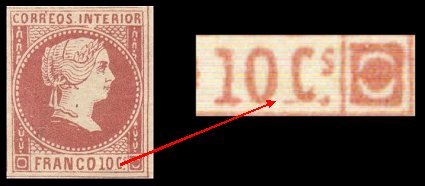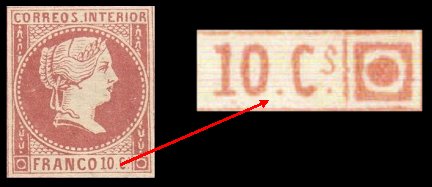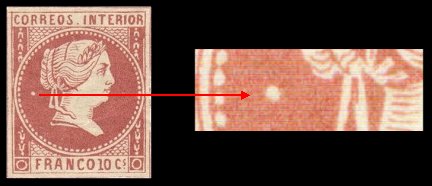Queen Isabella II
![]()
![]()
January 1, 1859
(Saturday)
|
|
|
|||||||||||||||||||||||||||||||||||||||||||||||||||||||||||||||||||||||||||||||||||||||||||||||||||||||||||||||||||||||||||||||||||||||||||||||||||||||||||||||||||||||||||||||||||||||||||||||||||||||||||||||||||||||||||||||||||||||||||||||||||||||||||||||||||||||||||||||||||||||||||||||||||||||||||||||||||||||||||||||||||||||||||||||||||||||||||||||||||||||||||||||||||||||||||||||||||||||||||||||||||||||||||||||||||||||||||||||||||||||||||||||||||||||||||||||||||||||||||||||||||||||||||||||||||||||||||||||||||||||||||||||||||||||||||||||||||||||||||||||||||||||||||||||||||||||||||||||||||||||||||||||||||||||||||||||||||||||||||||||||||||||||||||||||||||||||||||||||||||||||||||||||||||||||||||||
|
5-cuartos. Issued for domestic mail under half-an-ounce,
(single weight interior postal rate). A total of 15,000 stamps were issued in
shades of vermilion, scarlet, and orange. The stamps remained in use until
January 1861, with later usage also known. (Scott
#10,#10a and #10b; SG #13, #15, and #16; Edifil #7, #7a, #7b) 10-cuartos. Issued for domestic mail between half-an-ounce
and one ounce, (double weight interior postal rate). A total of 3,000 stamps
were issued in shades of rose and lilac-rose. The stamps remained in use
until January 1863. (Scott #11; SG #14;
Edifil #8 and #8a)
The stamps were lithographed by the firm of M. Perez y Hijo, in Generally speaking, but with exceptions noted below, the stamps
were printed in blocks of four varieties, each block being surrounded by an
outer frame line; with each stamp measuring 18½ x 23½ mm. Despite January 1, 1859 being recognised as the date these
stamps were officially placed on sale, a few covers are known with postmarks
displaying earlier dates. A cover with a large Baeza circular date stamp of
December 14, 1858 is in the Gooding collection (18 days before the official
date of issue).
DIFFERENTIATING BETWEEN THE FOUR VARIETIES Of the four varieties in the normal block, it may be said that
they may usually be distinguished, where the margins are sufficient, by a
portion of the outer frame line and the inner crossed lines between the
stamps, indicating from which corner of the block the copy came. Moreover,
the ornament in the vertical side labels are interrupted differently in each
type by the circle surrounding the pearls. Further differences, for both the
5-cuartos and 10-cuartos values, are as follows: UPPER LEFT OF CLICHE (TYPE 1) The circle around the portrait consists of 71 pearls. One pearl,
(slightly below the middle on the right side), is generally (though not
always) missing. The "C" of "CORREOS" leans backwards and
the "N" of "INTERIOR" is below the level of the
"I" and "T" adjoining it. The lowest row of the pattern
in the left lower spandrel contains 4½ semicircles, that in the right
contains 5 semicircles. In addition, in each case, there is a small white
space under the central disc, which almost forms a sixth semicircle at right. UPPER RIGHT OF CLICHE (TYPE 2) The circle around the portrait consists of 71 pearls, with none
missing. The "N" of "INTERIOR" is of an even height. The
lower part of the frame at the right side contains two complete ornaments and
almost the whole of a third (in the other varieties, there are two ornaments
and a very small fragment only). In the left lower spandrel the bottom row
contains 4 semicircles, and that the right contains 5 semicircles. LOWER LEFT OF CLICHE (TYPE 3) The circle around the portrait consists of 65 pearls, with none
missing. The "C" of "CORREOS" leans backwards a little.
The bottom row of the left spandrel contains 4½ semicircles and in the right
4 semicircles and a long narrow segment. LOWER RIGHT OF CLICHE (TYPE 4) The circle around the portrait consists of 67 pearls, with none
missing. The letter "N" of "INTERIOR" leans forward, and
there is a little white space in the spandrel immediately below this letter
(some copies of this variety do not show the white space). A scratch, which
is sometimes quite faint, crosses the fillet in the hair and extending to
between the "R" and "E" of "CORREOS". The
bottom row of the pattern in the left lower spandrel has 3½ semicircles, and
that in the right there are 4 semicircles and again a long narrow segment.
SHEET COMPOSITIONS There were five distinct lithographic stones (plates) used in
the various printings of the 5-cuartos value, issued between 1859 and 1861. The 10-cuartos value seems to have been printed entirely from
the one stone, prepared in 1859 along with the First Stone for the 5-cuartos
value. The arrangement of the stone is exactly like that of the First Stone
for the 5-cuartos except as to the order in which the types appear in the
vertical pairs at the right of the sheet. The 10-cuartos stone was prepared
by the transfer of the normal (5 Cs) design to the stone, then removing the
"5 Cs" and replacing it by "10 Cs" and retouching the
stone by hand. This is proved by the relative positions toward each other of
the "1" and "0", and both to the "O" of
"FRANCO" and the "C" of "Cs". The
"Cs" is also nearer to the frame line at the right, proving it to
have also been replaced. As a consequence, there are practically as many
varieties of the "10 Cs" as stamps to the sheet. FIRST STONE Produced in late 1858 to early 1859. This stone produced sheets
of 56 stamps (8 horizontal rows of 7 stamps each). Each sheet contained 12
blocks of the four types (3 horizontally and four vertically), and four
vertical pairs at the right of the sheet. Each block is surrounded by a
single-line frame. The following configurations apply: 5-Cuartos
10-Cuartos
Possibly produced at the same time as the First Stone. This
stone produced sheets of 56 stamps as per the First Stone, the only
difference is the appearance of the vertical pairs to the left of the sheet
(instead of on the right side as in the First Stone). 5-Cuartos
This stone was put in use in 1859, probably by July 1st, and
produced sheets of 192 stamps. Each sheet is arranged in four panes of 48
stamps each, with a gutter between the four panes on the sheet. Each pane
consisted of 8 horizontal rows of 6 stamps; hence, constituting 12 complete
blocks of the four varieties. 5-Cuartos
In 1860, a new stone was prepared and produced sheets of 130
stamps arranged in 13 horizontal rows of 10 stamps each. The first 12 rows
were composed of 30 complete blocks of the four varieties; the 13th (bottom)
row contained five horizontal pairs. The period between ‘CORREOS’ and
‘INTERIOR’ is sometimes absent. Most sheets, but not all, are without the
outer frame line around the blocks. 5-Cuartos
In 1861, a new stone was prepared and produced sheets of 130 stamps
arranged in 13 horizontal rows of 10 stamps. This stone is very similar to
the Fourth Stone except that in the 13th (bottom) row, the pairs appear in a
different order. Most sheets, but not all, are without the frame line around
the blocks. 5-Cuartos
PAPER TYPES AND CORRESPONDING PRINTING STONES
VARIETIES AND ERRORS 5-Cuartos. A used vertical block of six exists with a
watermark consisting of a fancy double-lined "A", a period, and a
portion of a second letter that looks more like an "F" (or probably
a P or a B). Printed on thick laid (ribbed) paper. The letters measure 15mm
vertically. The period, which is 1mm away from the right leg of the letter
"A", appears as a hollow circle with a diameter of 2mm. There is a
distance of 15mm from the period and the second letter. (Nestor Nunez Collection)
ROYAL DECREES AND ORDERS 1859 A Royal Order was issued commanding the
Superintendent of the Your Excellency: I have informed Her Majesty (may God keep Her many years)
of Your Excellency's Letter Number 1097 and the file accompanying it, regarding
the expenditure involved in the printing and gumming of stamps authorized in
the Philippine Islands for internal correspondence in that territory; and Her
Majesty, considering the matter, although She deemed fit to approve the said
expenditure, on the basis of a decision of the Higher Council of the Ministry
of Finance taken as a matter of urgency, desires that Your Excellency be told
that in the future, you should refrain from ordering the printing of stamps
in the Philippine Islands. You should request them sufficiently in advance
from the present Ministry whenever they are needed for the postal service, in
view of the fact that the said printing is subject to fraud, even if the
presence of an official of the Ministry of Finance is required during the
printing at the shop of the contracted lithographer. The latter, in spite of
complying with all the provisions of the bidding terms and conditions, keeps
the original stone at his residence during the time it takes to carry out the
said operation. During that period he can print more copies than those for
which he was contracted, and it is not possible for the employee assigned to
inspect the printing to be present at all hours in the lithographer's shop.
These difficulties can be resolved by inspection of the said printing in the
National Factory existing in the Capital for all types of effects bearing
seals. By Royal Order – San Idelfonso, August 18, 1859.
The Superintendent representing the Ministry of the Finance in the
Philippines |
|
|||||||||||||||||||||||||||||||||||||||||||||||||||||||||||||||||||||||||||||||||||||||||||||||||||||||||||||||||||||||||||||||||||||||||||||||||||||||||||||||||||||||||||||||||||||||||||||||||||||||||||||||||||||||||||||||||||||||||||||||||||||||||||||||||||||||||||||||||||||||||||||||||||||||||||||||||||||||||||||||||||||||||||||||||||||||||||||||||||||||||||||||||||||||||||||||||||||||||||||||||||||||||||||||||||||||||||||||||||||||||||||||||||||||||||||||||||||||||||||||||||||||||||||||||||||||||||||||||||||||||||||||||||||||||||||||||||||||||||||||||||||||||||||||||||||||||||||||||||||||||||||||||||||||||||||||||||||||||||||||||||||||||||||||||||||||||||||||||||||||||||||||||||||||||||||||
![]()
Comments and Feedback Always Welcome .... Please Email
Return to Home Page
![]()




